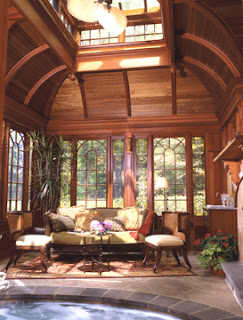How Does Your Sunroom
Grow?
by
Stephanie Cavanaugh
For
the Wall St Journal's OWN Magazine - September 2012
Molly
and Michael Metzler sleep under glass. Their bedroom opens to a domed
conservatory with marble floors and a panoramic view that skips across 15 acres
of garden and grounds to the lapping shore of Delaware's Nanticoke River.
From
the boudoir one also sees a free-standing conservatory nestled in a woodsy
setting and echoing the style of the 5,000 square foot main house. Molly
Metzler originally wanted a simple greenhouse, but the project grew, as these
things do, into a mahogany-lined, cupola-topped jewel-box, with windows set in
bronze.
"It's
much too nice to be a greenhouse," she says of the single-room building
that features a sitting area with a fireplace, a wet bar, and an in-ground spa
for splashing amid hibiscus flowers and banana trees in the middle of January.
"It's
just a place for my husband and me. We don't even let my son out there," then
adds with a laugh, "He's 21. You don't want one of those in your
spa."
It's June
in January
Fooling
mother nature is a great part of the allure of green houses, conservatories,
and orangeries. Though the terms are often used interchangeably, there are
differences between these structures.
Greenhouses,
which are generally detached from the house, are designed for the propagation
of plants, with heating and lighting controls to create the optimum environment
for your eupatoria and fritillaria.
Conservatories are usually attached to the house and allow
the harmonious cohabitation of plants and brunch.
The orangerie is a cousin to both. Originally designed
to grow citrus trees in climates too chilly to sustain them outdoors, they are
generally defined by a two-tiered roof that allows headroom for trees.
There
is, however, considerable overlap among the three forms. A conservatory might
have a domed roof and an orangerie a flat one, with no glassing at all. A
greenhouse can be used for reading as well as raising flowers and plants.
"We've
done greenhouses that incorporated relaxation rooms with tables and
chairs," says Rob Suman, president of Creative Conservatories, which is
based in Quakertown, Pennsylvania. "They're all glass structures, of
course, and very similar."
To be
frank (which is nice), he adds that whatever we call them, what we're talking
about is building magnificently ornamented sunrooms. Rooms that will
become, as he puts it, "the jewel of the house."
Having
been given Suman's absolution, and to simplify matters, we'll dispense with the
distinctions and simply call all of these glass rooms conservatories, since
that is their ultimate function: to conserve plants.


